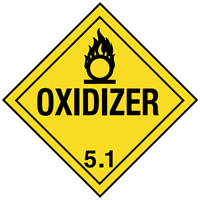
 Print
Print
Chemical Datasheet
TRICHLORO-S-TRIAZINETRIONE, DRY |

|
Chemical Identifiers
| CAS Number |
UN/NA Number |
DOT Hazard Label |
USCG CHRIS Code |
|
|
|
|
|
| NIOSH Pocket Guide |
International Chem Safety Card |
|
none
|
- TRICHLOROISOCYANURIC ACID
|
NFPA 704
General Description
A white slightly hygroscopic crystalline powder or lump solid with a mild chlorine-like odor. Said to have 85 percent available chlorine. Decomposes at 225°C. Moderately toxic by ingestion. May irritate skin and eyes. Active ingredient in household dry bleaches. Used in swimming pools as a disinfectant.
Hazards
Reactivity Alerts
- Strong Oxidizing Agent
- Water-Reactive
Air & Water Reactions
Slightly hygroscopic [Hawley]. Slightly soluble in water. May react with water releasing gaseous chlorine. If mixed with a small amount of water, the concentrated solution (with pH at about 2.0) may explode due to the evolution of unstable nitrogen trichloride. (explanation in Bretherick 5th ed.)
Fire Hazard
Special Hazards of Combustion Products: Toxic chlorine or nitrogen trichloride may be formed in fires.
Behavior in Fire: Containers may explode when heated. (USCG, 1999)
Health Hazard
Inhalation causes sneezing and coughing. Contact with dust causes moderate irritation of eyes and itching and redness of skin. Ingestion causes burns of mouth and stomach. (USCG, 1999)
Reactivity Profile
TRICHLORO-S-TRIAZINETRIONE, DRY is an oxidizer. It reacts with combustible materials or ammonium salts, resulting in fire. It is thermally unstable, and reacts with small amounts of water to release toxic chlorine gas and explosive nitrogen trichloride. Reaction of this compound with ammonia or amines also produces nitrogen trichloride. This compound reacts explosively with calcium hypochlorite and water. [NFPA 49, 14th ed. 2010]
Belongs to the Following Reactive Group(s)
- Salts, Acidic
- Acyl Halides, Sulfonyl Halides, and Chloroformates
- Oxidizing Agents, Strong
- Halogenating Agents
Potentially Incompatible Absorbents
Use caution: Liquids with this reactive group classification have been
known to react with the
absorbents
listed below.
- Cellulose-Based Absorbents
- Mineral-Based & Clay-Based Absorbents
- Expanded Polymeric Absorbents
- Dirt/Earth
Response Recommendations
Isolation and Evacuation
Excerpt from ERG Guide 140 [Oxidizers]:
IMMEDIATE PRECAUTIONARY MEASURE: Isolate spill or leak area in all directions for at least 50 meters (150 feet) for liquids and at least 25 meters (75 feet) for solids.
LARGE SPILL: Consider initial downwind evacuation for at least 100 meters (330 feet).
FIRE: If tank, rail tank car or highway tank is involved in a fire, ISOLATE for 800 meters (1/2 mile) in all directions; also, consider initial evacuation for 800 meters (1/2 mile) in all directions. If ammonium nitrate products are in a tank, rail car or truck and involved in a fire, ISOLATE for 1600 meters (1 mile) in all directions; also, initiate evacuation including emergency responders for 1600 meters (1 mile) in all directions. (ERG, 2024)
Firefighting
Fire Extinguishing Agents: Water in large amounts (USCG, 1999)
Non-Fire Response
Excerpt from ERG Guide 140 [Oxidizers]:
Keep combustibles (wood, paper, oil, etc.) away from spilled material. Do not touch damaged containers or spilled material unless wearing appropriate protective clothing. Stop leak if you can do it without risk. Do not get water inside containers.
SMALL DRY SPILL: With clean shovel, place material into clean, dry container and cover loosely; move containers from spill area.
SMALL LIQUID SPILL: Use a non-combustible material like vermiculite or sand to soak up the product and place into a container for later disposal.
LARGE SPILL: Dike far ahead of liquid spill for later disposal. (ERG, 2024)
Protective Clothing
Dust mask or chlorine canister mask; goggles; rubber gloves (USCG, 1999)
DuPont Tychem® Suit Fabrics
No information available.
First Aid
INHALATION: remove victim to fresh air.
EYES: irrigate with running water for 15 min.; call physician.
SKIN: flush with water.
INGESTION: induce vomiting and call physician. (USCG, 1999)
Physical Properties
Flash Point: data unavailable
Lower Explosive Limit (LEL): data unavailable
Upper Explosive Limit (UEL): data unavailable
Autoignition Temperature: data unavailable
Melting Point: data unavailable
Vapor Pressure: data unavailable
Vapor Density (Relative to Air): data unavailable
Specific Gravity:
greater than 1
at 68°F
(est)
(USCG, 1999)
Boiling Point: data unavailable
Molecular Weight:
232.5
(USCG, 1999)
Water Solubility: data unavailable
Ionization Energy/Potential: data unavailable
IDLH: data unavailable
AEGLs (Acute Exposure Guideline Levels)
No AEGL information available.
ERPGs (Emergency Response Planning Guidelines)
No ERPG information available.
PACs (Protective Action Criteria)
| Chemical |
PAC-1 |
PAC-2 |
PAC-3 |
| Trichloroisocyanuric acid (87-90-1)
|
0.0063 ppm |
0.07 ppm |
0.42 ppm |
(DOE, 2024)
Regulatory Information
EPA Consolidated List of Lists
No regulatory information available.
CISA Chemical Facility Anti-Terrorism Standards (CFATS)
No regulatory information available.
OSHA Process Safety Management (PSM) Standard List
No regulatory information available.
Alternate Chemical Names
- ACL 85
- ACL 90
- ACL 90 PLUS
- CDB 90
- CHLOREAL
- FI CLOR 91
- HI-LITE 90
- HI-LITE 90G
- ISOCYANURIC CHLORIDE
- N,N',N''-TRICHLOROISOCYANURIC ACID
- NEOCHLOR 90
- S-TRIAZINE-2,4,6(1H,3H,5H)-TRIONE, 1,3,5-TRICHLORO-
- S-TRIAZINE-2,4,6(1H,3H,5H)-TRIONE, TRICHLORO-
- SYMCLOSEN
- SYMCLOSENE
- TRICHLORO-S-TRIAZINE-2,4,6(1H,3H,5H)-TRIONE
- TRICHLORO-S-TRIAZINE-2,4,6-(1H, 3H, 5H)-TRIONE
- TRICHLORO-S-TRIAZINETRIONE
- TRICHLORO-S-TRIAZINETRIONE, DRY
- TRICHLORO-S-TRIAZINETRIONE, [DRY, CONTAINING > 39% AVAILABLE CHLORINE]
- TRICHLOROCYANURIC ACID
- TRICHLOROIMINOISOCYANURIC ACID
- TRICHLOROISOCYANURIC ACID
- TRICHLOROISOCYANURIC ACID, DRY
- TRICHLOROISOCYANURIC ACID, [DRY]
- 1,3,5-TRICHLOROISOCYANURIC ACID
- TRICHLOROTRIAZINETRIONE


 Print
Print
